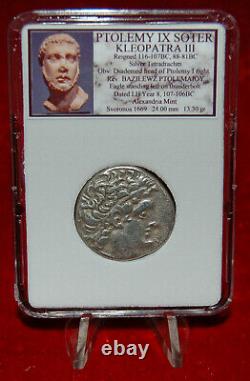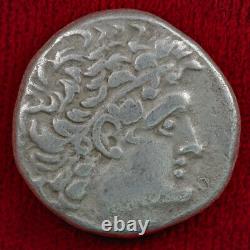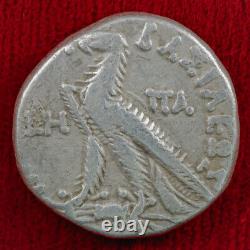Ancient Coin PTOLEMY IX and CLEOPATRA III Eagle Alexandria Silver Tetradrachm






Diademed head of Ptolemy I right. Eagle standing on thunderbolt left. Dated LH Year 8, 107-106BC. Please, check out other ancient coins we have available for sale. We are offering 1000+ ancient coins collection.
ALL COINS ARE GENUINE LIFETIME GUARANTEE. The attribution label is printed on archival museum quality paper. An interesting bronze coin of Ptolemy IX and Cleopatra minted in Alexandria.
Ptolemy I on obverse and eagle. This coin comes with display case, stand and attribution label attached as pictured. A great way to display an ancient coins collection. Only within the continental U. Ptolemy IX Soter II, commonly nicknamed Lathyros was twice King of Ptolemaic Egypt. He was the son of Ptolemy VIII and Cleopatra III. He reigned as Ptolemy Philometor Soter in joint rule with his grandmother Cleopatra II and mother Cleopatra III from 116 to 107 BC, and then again as Ptolemy Soter from 88 to 81 BC. After the murder of his elder brother Ptolemy Memphites in 130 BC, during a civil war between Ptolemy VIII and Cleopatra II, Ptolemy IX became the heir apparent. On his father's death in 116 BC, he became co-regent with Cleopatra II (until 115 BC) and with Cleopatra III. He eventually quarrelled with his mother and in 107 BC, she deposed him and replaced him with his younger brother Ptolemy X. However, Ptolemy IX succeeded in seizing control of Cyprus. From there he invaded Judaea, but was prevented by Ptolemy X from invading Egypt (103-102 BC). In 88 BC, the Alexandrians expelled Ptolemy X and restored Ptolemy IX to the throne. He reigned alone until 81 BC, when he appointed his daughter Berenice III as co-regent shortly before his own death. She succeeded him as ruler. When Ptolemy V had died in 180 BC, he had left three children: Ptolemy VI, Cleopatra II, and Ptolemy VIII. All three ruled together from 169 BC until 164 BC, when Ptolemy VIII expelled his brother from power. In 163 BC, he was expelled in turn and forced to withdraw to Cyrene. However, when Ptolemy VI died in 145 BC, Ptolemy VIII was invited back to Egypt to serve as king, marrying his sister Cleopatra II (who had previously been married to Ptolemy VI).The relationship between Ptolemy VIII and Cleopatra II rapidly deteriorated, especially when Ptolemy VIII took Cleopatra III (the daughter of Ptolemy VI and Cleopatra II), as a second wife. The conflict eventually led to a civil war with Cleopatra II on one side and Ptolemy VIII and Cleopatra III on the other (132-126 BC). Ptolemy VIII and Cleopatra III were victorious, but reconciled with Cleopatra II and restored her as co-regent in 124 BC. Ptolemy IX was the son of Ptolemy VIII and Cleopatra III.
The exact date of his birth is a bit unclear. As Pharaoh, his Horus name was "Distinguished through his birth together with the living Apis; twin in his birthplace with the son of Isis" which seems to indicate that he was born in the same year as an Apis bull, i.This would put his birth two years before his parents' marriage, which took place in 141 BC. Some historians, like Günther Hölbl, consider this insuperable and propose to place his birth in 140 or 139 BC instead. Initially, Ptolemy IX was not the heir to the throne - that was Ptolemy Memphites, the son of Ptolemy VI and Cleopatra II, who was roughly the same age as him. In 134/3, Ptolemy IX served as the annual Priest of Alexander the Great, the year after Memphites had done the same.
However, during the civil war, in 130 BC, Cleopatra II attempted to have Memphites crowned as her co-ruler, so Ptolemy VIII had him murdered, leaving Ptolemy IX as the heir. Around 117 BC, Ptolemy IX was sent to Cyprus, reportedly at his mother's request, where he served as governor of the island (strategos, nauarchos, archiereus, archikynegos).
Shortly before this he had married his sister, Cleopatra IV, who probably gave birth to two sons while the couple was on Cyprus: the future Ptolemy XII in 117 BC and the future Ptolemy of Cyprus around 116 BC. On 28 June 116, Ptolemy VIII died. According to Justin, Ptolemy VIII's will left Cleopatra III in charge of Egypt, with the right to choose either Ptolemy IX or his younger brother Ptolemy X as her co-regent. Cyrene was left to a third son, Ptolemy Apion. Justin further claims that Cleopatra III wanted to choose Ptolemy X, but the people of Alexandria rioted and forced her to choose Ptolemy IX.
Pausanias implies that Cleopatra III's request to send Ptolemy IX to Cyprus in 117 BC had been intended to get him out of the way in order to enable Ptolemy X's succession. Some historians have found this account plausible. However, Chris Bennett argues that it is a false story that was invented by Cleopatra III at a later date.He points out that Justin's story assumes that Cleopatra III was the only living queen at the time of Ptolemy VIII's death. Documentary evidence shows that Cleopatra II was still alive in 116 BC, which makes it unlikely that Cleopatra III would have been allowed sole power to decide who would be king. At any rate, Cleopatra II, Cleopatra III, and Ptolemy IX (in that order) are listed together as co-rulers in surviving papyrus documents from October 116 BC. Ptolemy IX received the epithet Philometor Soter (Mother-loving Saviour). This was the same epithet that Cleopatra II and taken on during her civil war with Ptolemy VIII and Cleopatra III, which suggests that she played a controlling role in the new regime.
Ptolemy X was sent to Cyprus to serve as governor of Cyprus soon after Ptolemy IX's accession. Divorce, remarriage, and intervention in Seleucid civil war. Cleopatra II died some time before April 115 BC and at this point Cleopatra III became the dominant force in the government. Ptolemy IX was forced to divorce his sister-wife Cleopatra IV, who went off and married the Seleucid king Antiochus IX Cyzicenus r. 115-95 BC, whose mother Cleopatra Thea was Cleopatra III's sister.
Her new husband was waging a war against his half-brother Antiochus VIII Grypus r. 125-96 BC, who was married to Cleopatra IV's elder sister Tryphaena.On the way to meet Antiochus IX, Cleopatra IV stopped in Cyprus, where she recruited an army and seized control of the Cypriot fleet, in order to aid Antiochus IX. Perhaps as a result of this, in 114/113 BC, Ptolemy X proclaimed himself'King of Cyprus', openly declaring his opposition to Ptolemy IX. Meanwhile, Ptolemy IX married his younger sister, Cleopatra Selene, with whom he soon had a daughter, Berenice III. Cleopatra Selene was not made co-regent with her new husband, as would have been normal. Instead, in documents from this period, the royal couple were Cleopatra III and Ptolemy IX, who were integrated into the Ptolemaic dynastic cult as the Theoi Philometores Soteres (The Mother-loving Saviour Gods).
Ptolemy IX supported Antiochus IX Cyzicenus in his conflict with Antiochus VIII Grypus. In 114 BC, Cleopatra IV had been captured and murdered by Antiochus VIII's wife Tryphaena, who was murdered in turn by Antiochus IX in 111 BC.
In 109 BC, Ptolemy IX sent Antiochus IX fresh troops to aid him in a campaign against the Jewish ruler Hyrcanus I of the Hasmonean dynasty. In autumn 107 BC, a new conflict broke out between Cleopatra III and Ptolemy IX.
Pausanias claims that Cleopatra III wounded a number of her own eunuch servants and displayed them to the people as evidence that her son had attempted to have her assassinated, causing the Alexandrians to riot and expel Ptolemy IX from the city. While this was taking place, Ptolemy X had left Cyprus and sailed to Pelusium.
Cleopatra III then had him brought to Alexandria and placed on the throne as her new co-regent. Ptolemy IX had left his two sons behind when he fled Alexandria. He also abandoned Cleopatra Selene, who now seems to have been married to Ptolemy X. King of Cyprus (107-88 BC). After his expulsion from Alexandria, Ptolemy IX went to the isle of Cyprus.
There forces loyal to Cleopatra III and Ptolemy X rebuffed him, forcing him to retreat to Seleucia in Pieria. From there he mounted another invasion of Cyprus in 106 BC, which succeeded in conquering the island. He initially maintained control of Cyrene, but it seems to have come under the control of his half brother Ptolemy Apion some time after 105 BC. Apion protected his position by publishing a will which left all his territories to Rome in the event that he died without heirs, a method which was often used by Hellenistic kings to prevent rivals from attempting to depose or assassinate them.
However, he actually died without heirs in 96 BC, meaning that Rome inherited the territory. In 103 BC, the new Hasmonean King Alexander Jannaeus led an army to conquer Ptolemais Akko. The city appealed to Ptolemy IX for help and he sailed over and caused Jannaeus to lift his siege. He then invaded Galilee, defeated Jannaeus in a battle at Asophon near the River Jordan, and despoiled Judaea with impunity.
Fearing that Ptolemy IX was planning to use Judaea as a springboard for an invasion of Egypt, Cleopatra III and Ptolemy X invaded Judaea themselves. Ptolemy X invaded Phoenicia by sea and then marched inland to Damascus, while Cleopatra III besieged Ptolemais Akko. Ptolemy IX attempted to slip past them and into Egypt, but Ptolemy X managed to rush back and stop him. Ptolemy IX spent the winter encamped at Gaza, before deciding to sail back to Cyprus in early 102 BC.
We hear nothing more about his activities until 88 BC. The army and people of Alexandria turned against Ptolemy X in spring 88 BC and expelled him from Egypt. The Alexandrians then recalled Ptolemy IX to the throne. Ptolemy IX was formally re-crowned as Pharaoh at Memphis in November. In his first reign, Ptolemy had borne the epithet Philometor Soter (Mother-loving saviour), but on his return he dropped the Philometor, since it recalled his mother.
The cults and memory of Cleopatra III and Ptolemy X seem to have been officially suppressed. Ptolemy sent a large force south in November 88 BC, under the command of the general Hierax. Thebes was quickly recaptured and severely sacked. Ptolemaic control was restored as far south as Philae, but Lower Nubia, which had come under the control of the kingdom of Meroe during the revolt, was not reclaimed. Roman claims and First Mithridatic War. After his expulsion from Alexandria, Ptolemy X made an attempt to invade Cyprus and recapture control, but was killed in the attempt. Before his death, however, he had taken out a large loan from the Roman Republic, in return for which he produced a will which left his kingdom to the Romans. Although they chose not to take advantage of this, the possibility of Roman intervention hung over Ptolemy IX for the rest of his reign and forced him to adopt a highly deferential posture with the Romans. In 86 BC, a Roman fleet commanded by Lucullus arrived in Alexandria seeking financial and military support against Mithridates VI of Pontus, with whom the Romans were fighting the First Mithridatic War (89-84 BC). Ptolemy hosted Lucullus magnificently, but did not offer him any material support. This was probably partially due to the confused political situation - the Roman war effort was being led by Sulla, but he had been declared an outlaw by the government in Rome led by Lucius Cornelius Cinna. Moreover, Mithridates VI had managed to capture Ptolemy's sons, who had been on Cos since 103 BC.On 5 August 81 BC, Ptolemy IX promoted his daughter Berenice III, who had previously been the wife and co-regent of Ptolemy X, to the status of co-regent. Some sources claim that Ptolemy IX had made Berenice III his co-regent at the start of his second reign in 88 BC, but all documentary evidence shows that he reigned alone until this point. Ptolemy died shortly thereafter, probably in December of the same year, leaving her alone on the throne. After a few months of sole rule, her cousin Ptolemy XI was placed on the throne as her co-regent, murdered her, was murdered himself, and was replaced by Ptolemy XII, another child of Ptolemy IX. In August 115 BC, Ptolemy IX travelled down the Nile to Elephantine in order to celebrate the festival there in honour of the Great God of the Nile - a traditional Pharaonic duty which was meant to give thanks for the inundation and ensure the success of the next.
The fact that Ptolemy IX carried this ritual out personally, rather than letting a local priest carry it out in his stead, shows the extent to which Ptolemy embraced the Pharaonic role. It is possible that construction of certain buildings occurred during the first reign of Ptolemy IX. This would have included work on the Dendera Temple complex and on the temple in Edfu. A Roman embassy led by the senator Lucius Memmius, arrived in Egypt in 112 BC. As part of his visit, he was given a tour of the Fayyum region.
Papyrus letters survive that instruct all local officials to treat him with the greatest respect and provide him with the most luxurious accommodation. The visit is a sign of the extent to which the Ptolemies now sought to conciliate the Roman Republic. It is also an early example of Roman tourism in Egypt, which would become a major phenomenon in the Roman imperial period. A set of four graffiti at Philae provide evidence for another set of early Roman tourists.Dated to 116 BC, they are the earliest known examples of the Latin language to be found in Egypt. Ptolemy IX is only known to have married twice, first to Cleopatra IV from around 119 BC until he was forced to divorce her in 115 BC, and secondly to Cleopatra Selene from 115 BC, until he abandoned her during his flight from Alexandria in 107 BC. At least three children are attested for Ptolemy IX. The birth dates and parentage of his two sons Ptolemy XII and Ptolemy of Cyprus are disputed.
According to Justin, Cleopatra Selene and Ptolemy IX had two children. The historian John Whitehorne noted that the existence of those two children is doubted and they might have died at a young age.
Ptolemy XII is referred to by Cicero and other ancient sources as an illegitimate son; Pompeius Trogus called him a "nothos" (bastard), while Pausanias wrote that Berenice III was Ptolemy IX's only legitimate offspring. This has discouraged the identification of Ptolemy XII and Ptolemy of Cyprus with the two sons mentioned by Justin.
Michael Grant suggested that Ptolemy XII's mother was a Syrian or a partly Greek concubine while Günther Hölbl suggested that she was a member of the Egyptian elite. However, John Pentland Mahaffy and Christopher Bennett argue that they were considered illegitimate simply because their mother had not been a co-regnant queen. They propose Cleopatra IV as the mother, in which case Ptolemy XII and Ptolemy of Cyprus would have been born in 117 and 116 BC respectively.
Bennett further proposes that Ptolemy XII and Ptolemy of Cyprus are identical with the two sons mentioned by Justin. The mother of Ptolemy IX's daughter, Berenice III is not certain either. Cleopatra IV and Cleopatra Selene are candidates, with the former favoured by modern scholarship.
Bennett noted that Berenice III's legitimacy was never questioned by ancient historians, and the illegitimacy of Ptolemy IX and Cleopatra IV's marriage makes it more probable that Berenice III was the result of a legitimate marriage, that is between her father and Cleopatra Selene. Hellenistic soldiers in tunic, 100 BC, detail of the Nile mosaic of Palestrina. The Ptolemies came to rule Egypt after the arrival of Alexander the Great (356-323 BCE) in 332 BCE. At the time, the end of the Third Intermediate Period, Egypt had been ruled as a Persian satrapy for a decade-indeed that was the case in Egypt off and on since the 6th century BCE. Alexander had just conquered Persia, and when he arrived in Egypt, he had himself crowned as the ruler in the Temple of Ptah at Memphis.
Shortly afterward, Alexander left to conquer new worlds, leaving Egypt in the control of various Egyptian and Greco-Macedonian officers. When Alexander unexpectedly died in 323 BCE, his only heir was his mentally unpredictable half-brother, who was set to rule jointly with Alexander's as-yet-unborn son Alexander IV. Although a regent had been established to support the new leadership of Alexander's empire, his generals did not accept that, and a War of Succession broke out among them.
Some generals wanted all of Alexander's territory to stay unified, but that proved untenable. Three great kingdoms arose from the ashes of Alexander's empire: Macedonia on the Greek mainland, the Seleucid empire in Syria and Mesopotamia, and the Ptolemies, including Egypt and Cyrenaica. Ptolemy, the son of Alexander's general Lagos, was first established as the governor of the satrapy of Egypt, but officially became the first Ptolemaic pharaoh of Egypt in 305 BCE. Ptolemy's portion of Alexander's rule included Egypt, Libya, and the Sinai Peninsula, and he and his descendants would make up a dynasty of 13 rulers for close to 300 years.
Alexander's three great kingdoms jockeyed for power during the third and second centuries BCE. The Ptolemies attempted to expand their holdings in two areas: the Greek cultural centers in the eastern Mediterranean and Syria-Palestine.War elephants were essentially the tanks of the era, a strategy learned from India and used by all sides. By the 4th century BCE, Alexandria had a trained force of 57,600 infantry and 23,200 cavalrymen. Alexandria was founded by Alexander the Great in 321 BCE and it became the Ptolemaic capital and a major showcase for Ptolemaic wealth and splendor. It had three main harbors, and the city's streets were planned on a chessboard pattern with the main street 30 m (100 ft) wide running east-west across the city.
That street was said to have been aligned to point to the rising sun on Alexander's birthday, July 20, rather than that of the summer solstice, June 21. The four major sections of the city were the Necropolis, known for its spectacular gardens, the Egyptian quarter called Rhakotis, the Royal Quarter, and the Jewish Quarter. The Sema was the burial place of the Ptolemaic kings, and for a while at least it contained the body of Alexander the Great, stolen from the Macedonians.
His body was said to have been stored in a gold sarcophagus at first, and then later replaced by a glass one. The city of Alexandria also boasted of the Pharos lighthouse, and the Mouseion, a library and research institute for scholarship and scientific inquiry. The library of Alexandria held no fewer than 700,000 volumes, and the teaching/research staff included scientists such as Eratosthenes of Cyrene (285-194 BCE), medical specialists such as Herophilus of Chalcedon (330-260 BCE), literary specialists like Aristarchus of Samothrace (217-145 BCE), and creative writers like Apollonius of Rhodes and Callimachus of Cyrene (both third century). The Ptolemaic pharaohs held lavish panhellenic events, including a festival held every four years called the Ptolemaieia which was intended to be equal in status to the Olympic games.
Royal marriages established among the Ptolemies included both full brother-sister marriages, beginning with Ptolemy II who married his full sister Arsinoe II, and polygamy. Scholars believe these practices were intended to solidify the pharaohs' succession.
Major state temples were numerous throughout Egypt, with some old temples rebuilt or embellished, including the temple of Horus the Behdetite at Edfu, and the temple of Hathor at Dendera. The famous Rosetta Stone, which proved to be the key to unlocking the ancient Egyptian language, was carved in 196 BCE, during the reign of Ptolemy V. The Fall of the Ptolemies. Outside of the wealth and opulence of Alexandria, there was famine, rampant inflation, and an oppressive administrative system under the control of corrupt local officials.Discord and disharmony arose by the late third and early second centuries BCE. Civil unrest against the Ptolemies expressing the disaffection among the Egyptian population was seen in the form of strikes, the despoliation of temples, armed bandit attacks on villages, and flight-some cities were completely abandoned. At the same time, Rome was growing in power throughout the region and in Alexandria.
A long drawn out battle between the brothers Ptolemy VI and VIII was arbitrated by Rome. A dispute between the Alexandrians and Ptolemy XII was resolved by Rome.
Ptolemy XI left his kingdom to Rome in his will. The last Ptolemaic pharaoh was the famous Cleopatra VII Philopator ruled 51-30 B. Who ended the dynasty by allying herself with the Roman Marc Anthony, committing suicide, and turning over the keys of the Egyptian civilization to Caesar Augustus. The Roman dominion over Egypt lasted until 395 CE. Ptolemy I (aka Ptolemy Soter), ruled 305-282 BCE. Ptolemy II ruled 284-246 BCE. Ptolemy III Euergetes ruled 246-221 BCE. Ptolemy IV Philopator ruled 221-204 BCE. Ptolemy V Epiphanes, ruled 204-180 BCE. Ptolemy VI Philometor ruled 180-145 BCE. Ptolemy VIII ruled 170-163 BCE.Euregetes II ruled 145-116 BCE. Ptolemy X Alexander ruled 107-88 BCE.
Soter II ruled 88-80 BCE. Berenike IV ruled 58-55 BCE. Ptolemy XII ruled 80-51 BCE. Ptolemy XIII Philopator ruled 51-47 BCE.Ptolemy XIV Philopator Philadelphos ruled 47-44 BCE. Cleopatra VII Philopator ruled 51-30 BCE.
Ptolemy XV Caesar ruled 44-30 BCE. If you have a problem with your item please refrain from leaving negative or neutral feedback until you have made contact and given a fair chance to rectify the situation. As always, every effort is made to ensure that your shopping experience meets or exceeds your expectations. This item is in the category "Coins & Paper Money\Coins: Ancient\Greek (450 BC-100 AD)". The seller is "timelessthing" and is located in this country: US.
This item can be shipped to United States, Canada, United Kingdom, Denmark, Romania, Slovakia, Bulgaria, Czech Republic, Finland, Hungary, Latvia, Lithuania, Malta, Estonia, Australia, Greece, Portugal, Cyprus, Slovenia, Japan, China, Sweden, Korea, South, Indonesia, Taiwan, South Africa, Thailand, Belgium, France, Hong Kong, Ireland, Netherlands, Poland, Spain, Italy, Germany, Austria, Bahamas, Israel, Mexico, New Zealand, Philippines, Singapore, Switzerland, Norway, Saudi Arabia, United Arab Emirates, Qatar, Kuwait, Bahrain, Croatia, Republic of, Malaysia, Brazil, Chile, Colombia, Antigua and Barbuda, Aruba, Belize, Dominica, Grenada, Saint Kitts-Nevis, Saint Lucia, Montserrat, Turks and Caicos Islands, Barbados, Bangladesh, Bermuda, Brunei Darussalam, Bolivia, Ecuador, Egypt, French Guiana, Guernsey, Gibraltar, Guadeloupe, Iceland, Jersey, Jordan, Cambodia, Cayman Islands, Liechtenstein, Sri Lanka, Luxembourg, Monaco, Macau, Martinique, Maldives, Nicaragua, Oman, Peru, Pakistan, Paraguay, Reunion, Vietnam, Uruguay.
- Certification: Uncertified
- Grade: Ungraded
- Composition: Silver
- Denomination: Tetradrachm
- Era: Ancient


